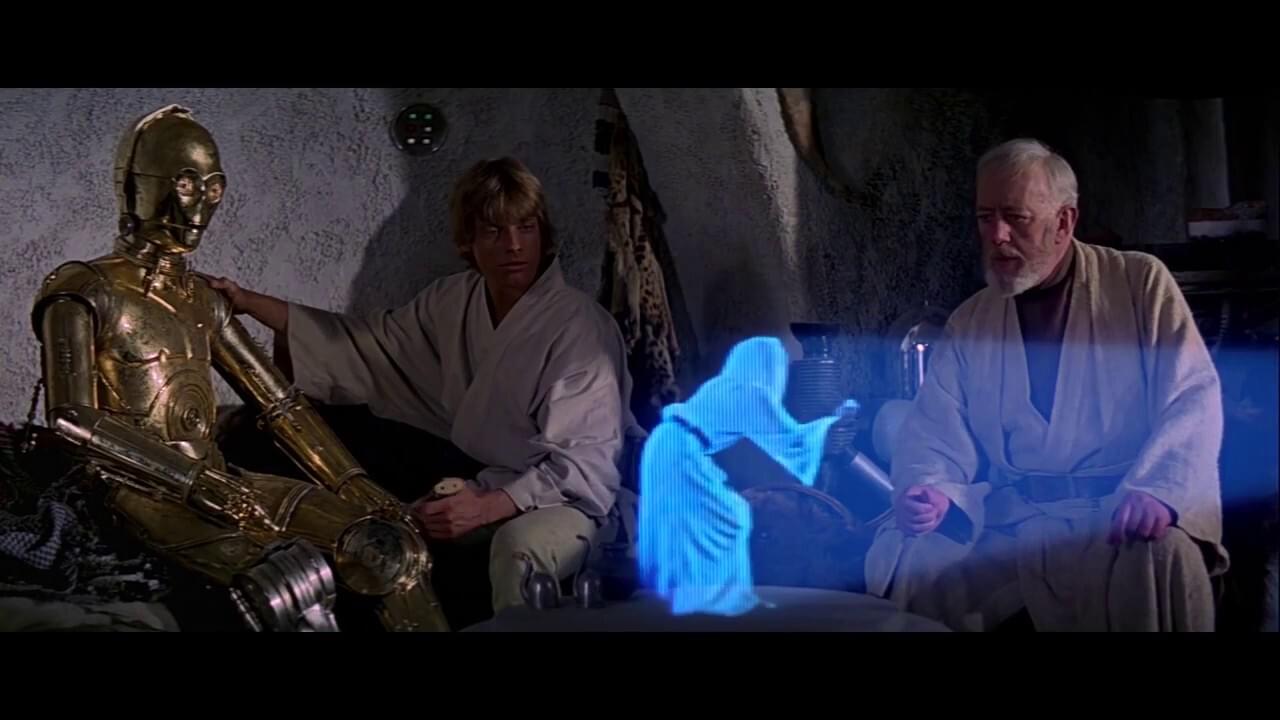Picture: CBS Studios Inc.
Picture: CBS Studios Inc.
“Beam me up, Scotty!” – Digital signage (almost) enables teleporting!
The device can, for example, display pre-recorded content that communicates interactively with the user via gesture and voice control. Non-interactive animations can of course also be played in a loop and are a guaranteed eye-catcher due to the three-dimensionality of the display. You can imagine it like the call for help, which the young Carrie Fisher records as Princess Leia on the small robot R2D2 in the original Star Wars and which she sends to the Jedi master Obi Wan Kenobi.
The holographic livestream
However, the full potential is only unleashed when the user is confronted with a holographic livestream. The person who is recorded elsewhere by 3D cameras and projected as a hologram hears and sees exactly the same on displays as if he were really there. A direct interaction with the people on site is therefore no problem and appears extremely realistic for the users, especially due to the three-dimensional representation.
At ComicCon, visitors could already interact with their favourite comic characters and other important people from the scene via the Holoportl and try out themselves as holograms. According to CEO David Nussbaum, the technology was generally very well received. The users visibly enjoy the interaction and spend much longer in front of the column than in front of other interactive displays.
The device can, for example, display pre-recorded content that communicates interactively with the user via gesture and voice control. Non-interactive animations can of course also be played in a loop and are a guaranteed eye-catcher due to the three-dimensionality of the display. You can imagine it like the call for help, which the young Carrie Fisher records as Princess Leia on the small robot R2D2 in the original Star Wars and which she sends to the Jedi master Obi Wan Kenobi.
The holographic livestream
However, the full potential is only unleashed when the user is confronted with a holographic livestream. The person who is recorded elsewhere by 3D cameras and projected as a hologram hears and sees exactly the same on displays as if he were really there. A direct interaction with the people on site is therefore no problem and appears extremely realistic for the users, especially due to the three-dimensional representation.
At ComicCon, visitors could already interact with their favourite comic characters and other important people from the scene via the Holoportl and try out themselves as holograms. According to CEO David Nussbaum, the technology was generally very well received. The users visibly enjoy the interaction and spend much longer in front of the column than in front of other interactive displays.

Is the future holographic?
Whether we will see more of the Holoportl in the future remains to be seen, but the probability is very high. The devices used to record the hologram and to play it are still relatively large and cost-intensive, but the technology is promising. The users obviously enjoy this kind of interactive technology and it is exactly this successful user experience that is known to pave the way for a technology. Only the haptic issue is (logically) still a problem with holograms. But even here one can be curious to see what the clever minds in the Augmented Reality innovation laboratories come up with. Perhaps we will soon see a human live hologram walking through the city on a faceless robot shell.
Critics may say that a real hologram is a pictorial 3D representation floating freely in space and that PORTL’s technology is not a hologram in the narrower sense. The technology magazine mobileGeeks has published an interesting article on real and fake holograms. Nevertheless, the spatial representation shown by PORTL is an interesting approach to the interactive design of screens and sets the direction for future innovations.
One thing is certain: technical development will certainly not be boring in the future.
Is the future holographic?
Whether we will see more of the Holoportl in the future remains to be seen, but the probability is very high. The devices used to record the hologram and to play it are still relatively large and cost-intensive, but the technology is promising. The users obviously enjoy this kind of interactive technology and it is exactly this successful user experience that is known to pave the way for a technology. Only the haptic issue is (logically) still a problem with holograms. But even here one can be curious to see what the clever minds in the Augmented Reality innovation laboratories come up with. Perhaps we will soon see a human live hologram walking through the city on a faceless robot shell.
Critics may say that a real hologram is a pictorial 3D representation floating freely in space and that PORTL’s technology is not a hologram in the narrower sense. The technology magazine mobileGeeks has published an interesting article on real and fake holograms. Nevertheless, the spatial representation shown by PORTL is an interesting approach to the interactive design of screens and sets the direction for future innovations.
One thing is certain: technical development will certainly not be boring in the future.